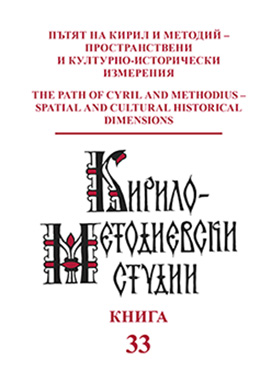Пътят на дубровнишката и брашовската търговия по българските земи (Според кирилски паметници от XIII–XIV в.)
The History of the Dubrovnik and Brasov Trading on Bulgarian Lands, According to the Cyrillic Sources (13th–14th c.)
Author(s): Teodora GeorgievaSubject(s): Language studies, Language and Literature Studies
Published by: Кирило-Методиевски научен център при Българска академия на науките
Keywords: trade; Bulgarian lands; Dubrovnik; Brasov; Vidin.
Summary/Abstract: From the end of 12th c. and the first half of 13th century, the Dubrovnik merchants steadily directed their economic interests to the inland of the Balkan Peninsula and purposefully developed overland trade. With the Dubrovnik charter (1230), the agricultural relations between the Bulgarian State and Ragusa were officially granted regulation. The relationship between Bulgarian and Dubrovnik had grown even in the 50s of the 13th century, under the reign of Michael II Asen. Trade-Economical and political contacts found their way into the newly written official document on the 15th of June 1253. This act established the release of paying kommerkion, which income to the fisc would be considered high. This way rights of the Bulgarian representatives were regulated, realizing trading on the land of Ragusa. Shown bilateral relations between Bulgaria and Dubrovnik reflect political and economic processes occurring in the Balkans during the first half of the 13th century. The amplified participation of foreign merchants, firstly the people from Dubrovnik then continued with people from Venice and Genoa, allowed the Bulgarian country to join in on the international trade. The said liveliness in the trade gave decent economic growth for the country and generated said financial resources. The relationship between the two countries continued for a hundred more years, especially with the Vidin kingdom of Joan Stratsimir. Vidin acted as a bridge linking Ragusa with Wallachia, which enabled them to participate in international trade. Mentioning the Vidin kingdom and the activity of the trading, this inevitably points to the Brasov charter, issued by Joan Stratsimir. This document represents a reporting message to the notables of Brasov city (Kronstadt), informing the citizens to roam and trade freely in the lands ruled by Joan Stratsimir. The review of these Cyrillic sources, like the Dobrovnik charter, the contract from 1253 and the document in favour of the citizens of Brasov, indicates that the Bulgarian lands actively participated in the trading. The more foreign representatives there were, it required regulations on the exchange. From the available documents, we know that legal relations were realized with the people from Dubrovnik, Venice and Genoa and citizens of Brasov. Considering the documents, they serve as facts of the entry of the exchange in the legal frameworks of the Bulgarian country, also the relations with foreign countries and the economic development during the 13th–14th c. period.
Journal: Кирило-Методиевски студии
- Issue Year: 2023
- Issue No: 33
- Page Range: 339-352
- Page Count: 14
- Language: Bulgarian
- Content File-PDF

